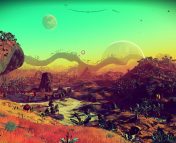Title: Oxygenic photosynthetic responses of cyanobacteria exposed under an M-dwarf starlight simulator: Implications for exoplanet habitability
Authors: Mariano Battistuzzi, Lorenzo Cocola, Riccardo Claudi, Anna Caterina Pozzer, Anna Segalla, Diana Simionato, Tomas Morosinotto, Luca Poletto, Nicoletta La Rocca
First Author’s Institution: University of Padua, Padua, Italy
Status: Submitted to Plant Physiology, a section of the journal Frontiers in Plant Science. Available on arXiv.
The Sun, our host star, has a spectrum that peaks in the visible light (from 400-700 nm). This is why we, humans, have the ability to see in these wavelengths – they were most useful for our survival as that is where most of the information given by our starlight would be. This is also the case for other lifeforms on Earth – they maximize the use of Solar light for their own survival. One example of this is a type of bacteria that can do photosynthesis – called cyanobacteria. The cyanobacteria here on Earth, in particular, have a type of compound called chlorophyll a, whose absorbance spectrum is shown in Figure 1. However, a recent study found that some cyanobacteria have the ability to adapt! In particular, there are a few species which can change their chlorophyll a to another types of chlorophyll, like d and f, which absorb longer wavelengths (i.e., redder colors) than chlorophyll a. They adapted to have this feature (called Far Red Light Photoacclimation, or FaRLiP for short) since some cyanobacteria live in environments with a lot of light scattering and attenuation, like inside of caves.
Okay, this is all super cool, but what does it have to do with astronomy???
Well, the authors of today’s paper simulated the starlight of M-dwarfs, which are cool, small and red stars, to see if cyanobacteria could grow under the wavelengths provided by these stars. The reason for this choice is that most exoplanets that have been detected to date that are in the habitable zone are orbiting M-dwarfs! So, one must wonder, could these sneaky little organisms make it under these conditions?
The Set-Up!
The set up of their experiment is shown in Figure 2. The petri dish with cyanobacteria is inside a chamber that is temperature controlled at 30 C (about 90 F), with CO2 and O2 sensors. The Star Light Simulator device (SLS), developed by the same authors, is placed directly above the chamber and has software controls to change into two different spectra: an M7 spectrum (simulating the red M-dwarf), a SOL spectrum (simulating Solar light) and a FR spectrum (simply far-red light with a peak at 750 nm). They use two types of bacteria: PCC6912 (capable of FarLiP) and PCC6803 (incapable of FaRLiP), let the bacteria acclimate, and grow for 21 days in the chamber.
The Results!
The authors use the Optical Density (OD) to measure bacterial growth and the O2 measurements from their sensor to track photosynthesis in the chamber. They find that both bacteria were able to grow under SOL and M7 light conditions. However, for FR conditions, only PCC6912 (the one capable of FaRLiP) was able to grow, although it was slowed down compared to the other two conditions. The results are shown in Figure 3.
Overall, they concluded that both strains acclimated to M7 and SOL lights despite different availability of visible light in two spectra. The bacteria without FaRLiP capability, PCC6803, must have adjusted its light harvesting capabilities to use red light efficiently in combination with visible light. Therefore, they demonstrated that cyanobacteria can grow and adapt to live in an exoplanet orbiting an M-dwarf’s habitable zone, and we could possibly detect such organisms using the red edge, a spectral feature at ~ 750 nm caused by photosynthetic organisms… Well, here’s to finding some alien cyanobacteria!
Astrobite edited by Maryum Sayeed
Featured Image Credit: Luke Thompson from Chisholm Lab and Nikki Watson from Whitehead, MIT




